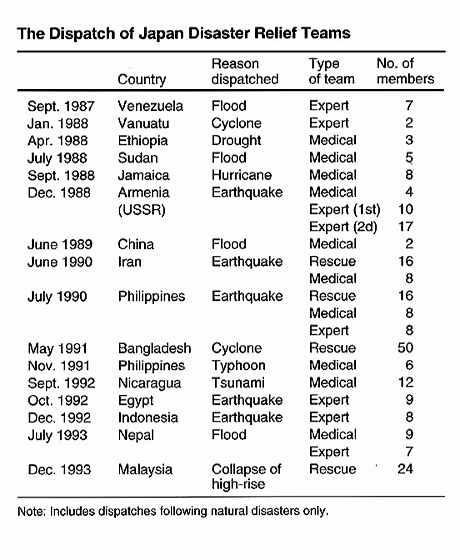Disaster Prevention
Japan's Cooperation with Global Disaster Prevention Efforts and Disaster Relief Operations
Bilateral Official Development Assistance (ODA) in Disaster Prevention
Stability in the foundations of society and national living standards is vital to economic progress in developing countries. Achieving such stability requires making countries physically disaster-resistant. Many developing countries are unable to take full advantage of the scientific and technical advances in fighting disasters, however, and the low level of development prevents sufficient resources from being allocated to disaster prevention measures. As a consequence, many developing countries suffer from a vicious circle of low-level development and disaster-related damage, and this makes natural disasters a particularly serious problem for these countries. In addition, many developing countries are situated in or near the Tropical Zone, where cyclones and other natural disasters are common, and a significant number of countries suffer from volcanic eruptions and other forms of disasters.
APPLYING JAPAN'S EXPERIENCE TO DEVELOPING COUNTRIES: Japan is subject to frequent natural disasters, including earthquakes, storms and floods, and landslides. Consequently, it has a long history of battling natural disasters, and it has been able to overcome their impact to some extent. Japan's disaster prevention technology is now among the most advanced in the world, and the country has for many years been actively offering technical cooperation for disaster prevention activities in developing countries as well as providing funds.
Japan has long been an active provider of a wide range of development assistance, and it will continue to draw upon its experience in fighting disasters and its accumulated prevention technology to carry out an active program of assistance in the field of disaster prevention.
The damage inflicted by natural disasters is a major factor preventing the developing countries from improving their living environment. As such, disaster prevention should best be viewed as an environmental issue in the wide sense. The ODA Charter adopted by the cabinet in June 1992 gives priority to environment-related aid, and assistance for disaster prevention is one field that will be actively promoted.
EXAMPLES OF JAPAN'S AID: Japan's disaster prevention assistance covers a wide field. In the field of volcanoes and erosion control, Japan provided funding for the equipment used for disaster rehabilitation and reconstruction following the Mt. Pinatubo eruption in the Philippines and cooperation with a plan to control mud flows and flooding of volcanic deposits. Financial assistance was provided to Indonesia for an emergency volcanic disaster prevention project on Mt. Kelud and Mt. Merapi, and cooperation is being provided for the creation of a center to train experts on volcanic erosion control.
As for typhoon-related aid, financial assistance is provided for cyclone relief operations in Bangladesh, which suffers heavy damage from cyclones virtually every year. And help is extended in such forms as the formulation of a master plan for flood control and in the provision of equipment to create a meteorological microwave network for disaster prediction. Cooperation was also extended to build schools able to withstand typhoons in the Philippines, and embankments were built in Nepal for flood control.
As for earthquake-related disasters, comprehensive technical cooperation is being provided to Mexico and Peru by Japanese experts covering research, training, and information dissemination activities. Seismographic equipment has been provided to Venezuela, Colombia, and Fiji. Seismographic trainees have been invited from many developing countries.
Contributions to Multilateral Institutions
Japan contributes generously to organizations involved in emergency relief activities, including the Department of Humanitarian Affairs/Office of the United Nations Disaster Relief Coordinator, as well as other multilateral organizations working in areas relating to disaster prevention, such as the World Meteorological Organization. In addition, Japan has contributed $500,000 each year since fiscal 1990 to the IDNDR Trust Fund.
On the occasion of the World Conference on Natural Disaster Reduction, the Development Assistance Committee of the Organization for Economic Cooperation and Development published Guidelines on Disaster Mitigation that describes areas that need to be taken into account in providing disaster prevention assistance to developing countries. This document was developed on the basis of a report prepared by Japan.
Japan Disaster Relief Team (JDR)
It became evident from carrying out relief activities following the September 1985 earthquake in Mexico and volcanic eruption in Colombia two months later that a comprehensive approach to international disaster relief, including the dispatch of personnel, was necessary. Thus the Diet passed the Law Concerning the Dispatch of Japan Disaster Relief Teams in August 1987, and the law was put into force the following month.
Since then, Japan Disaster Relief Teams have been dispatched from a humanitarian standpoint to major disaster areas, especially in developing countries, to carry out rescue operations, provide medical care, and carry out rehabilitation activities as well as emergency activities to mitigate damage in response to requests for help from the governments of the affected countries.

Back to Index
